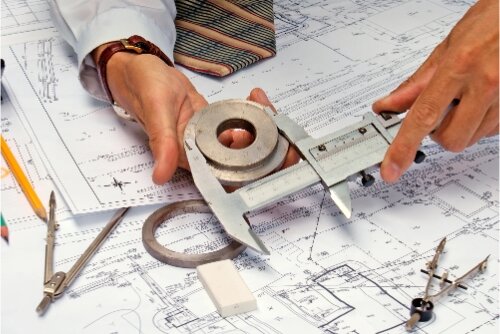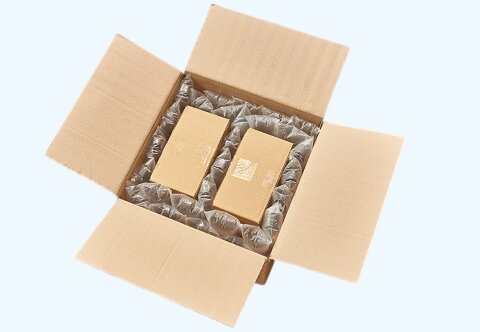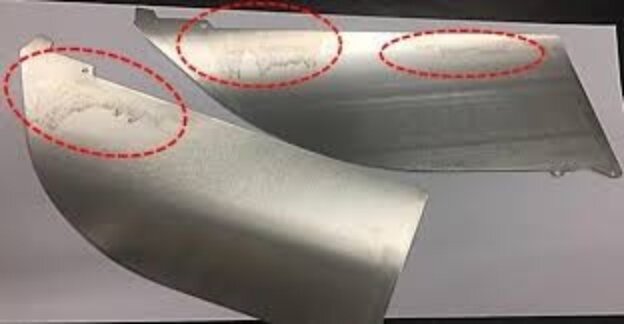Manufacturers face constant pressure to produce lightweight, durable, and cost-effective components. Traditional methods often fall short, increasing production costs and decreasing competitiveness. Aluminum stamping emerges as a game-changing solution, offering a perfect blend of strength, versatility, and affordability.
Aluminum stamping is transforming modern manufacturing by enabling the production of lightweight, strong, and corrosion-resistant components at scale. This process combines the malleability of aluminum with the precision of stamping technology, resulting in parts that meet strict tolerances while reducing overall product weight and costs.
Let’s explore how aluminum stamping reshapes the manufacturing landscape and why it’s becoming indispensable for the automotive and aerospace industries.
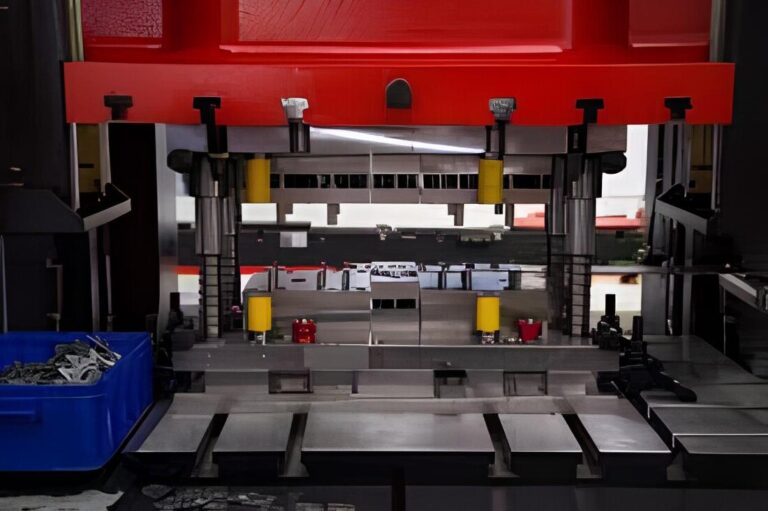
Understanding the Basics of Aluminum Stamping
What is Stamping in Metal Fabrication?
Stamping in metal fabrication is a high-speed, high-volume manufacturing process. It involves using specialized tools and dies to shape flat sheet metal into specific forms. For aluminum stamping, we start with aluminum sheet stock. The process applies force to the metal, causing it to conform to the shape of the die.
Benefits of Stamped Aluminum Sheet Metal Parts
Stamped aluminum parts offer numerous advantages in modern manufacturing:
- Lightweight: Aluminum is naturally light, making it perfect for industries where weight reduction is crucial.
- Corrosion resistance: Aluminum forms a protective oxide layer, enhancing durability in various environments.
- Cost-effective: The high-speed nature of stamping reduces production costs, especially for large volumes.
- Excellent strength-to-weight ratio: Stamped aluminum parts provide robust performance without adding excessive weight.
Choosing Aluminum Alloy for Metal Stamping
Selecting the right aluminum alloy is crucial for successful stamping. Here are key factors to consider:
- Formability: Alloys like 1100 and 3003 offer excellent formability, making them ideal for complex shapes.
- Strength requirements: 5052 and 6061 alloys provide higher strength for more demanding applications.
- Heat treatability: 6061 can be heat-treated post-stamping for enhanced mechanical properties.
- Cost: 1100 and 3003 are often more economical for large-volume production.
How to Stamp Aluminum?
The aluminum stamping process involves several key steps:
- Design: Engineers create the part design using CAD software, considering material properties and stamping limitations.
- Die creation: Custom dies are manufactured based on the part design, often using hardened steel for durability.
- Material preparation: Aluminum sheets are cut to size and lubricated to reduce friction during stamping.
- Stamping: The press applies force to the aluminum sheet, forming it into the desired shape using the custom die.
- Trimming: Excess material is removed to achieve the final part dimensions.
Types of Stamping Aluminum Process
Single-Stage Stamping
Single-stage stamping is a straightforward process where a single die performs one operation on the aluminum sheet. This method is ideal for simple parts or low-volume production runs.
Progressive Die Stamping
Progressive die stamping is a more advanced technique that performs multiple operations as the aluminum sheet moves through several stamping stations. Each station adds a new feature or modification to the part.
Transfer Press Stamping
Transfer press stamping is a hybrid approach combining single-stage and progressive die-stamping elements. It uses a series of single dies, with parts transferred between stages by an automated system.
Deep Draw Stamping for Aluminum Parts
Deep draw stamping is a specialized process for creating parts with significant depth, such as cups, cans, or enclosures. Aluminum is particularly well-suited for this metal due to its high flexibility.
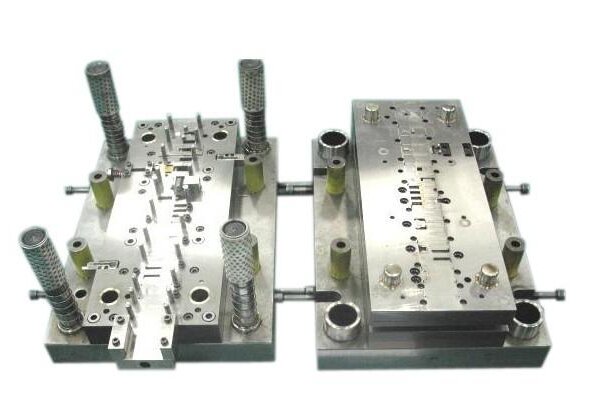
The Role of Tooling in Aluminum Stamping
Tooling is critical in the aluminum stamping process, directly impacting production’s quality, efficiency, and cost-effectiveness. The right tools ensure precise, consistent results while minimizing material waste and production downtime.
Key components of aluminum stamping tooling include:
- Dies: These are the moulds that shape the aluminum sheet.
- Punches: Used to create holes or cut-outs in the aluminum.
- Stripper plates: Help remove the stamped part from the die.
- Guide pins: Ensure proper alignment of the upper and lower die sections.
Aluminum Stamping Techniques and Best Practices
Blanking and Piercing for Precise Aluminum Cuts
Blanking and piercing are fundamental techniques in aluminum stamping that create precise cuts and openings in the material. These processes require attention to detail for optimal results:
Blanking:
- Use sharp, well-maintained cutting edges to minimize burrs.
- Optimize clearance between punch and die for clean cuts.
- Consider using a stepped punch to reduce impact and improve cut quality.
Piercing:
- Maintain proper punch-to-material thickness ratios to prevent deformation.
- Employ high-speed piercing for cleaner holes in thin aluminum sheets.
- Multi-stage piercing for thicker materials is used to reduce stress on tools.
Bending and Forming Aluminum with Accuracy
Achieving precise bends and forms in aluminum requires attention to detail:
- Account for spring back by overbending slightly, as aluminum tends to return to its original shape partially.
- Use the correct bend radius to prevent cracking, typically 1 to 3 times the material thickness.
- Orient bends perpendicular to the grain direction when possible for better results.
Coining and Embossing: Adding Features to Aluminum Parts
Coining and embossing enhance aluminum parts with detailed features:
- Design dies with proper relief angles to allow material flow during coining.
- Use higher pressures for coining to achieve crisp, well-defined features.
- Control material thickness variations to ensure uniform embossing depth.
Surface Treatments and Finishing for Stamped Aluminum Parts
Anodizing for Enhanced Corrosion Resistance
Anodizing is a popular surface treatment for stamped aluminum parts:
- Creates a durable, corrosion-resistant oxide layer on the aluminum surface
- Allows for a wide range of color options through dye absorption
- Improves wear resistance and hardness of the surface
- Maintains the part’s electrical insulation properties
- Provides a long-lasting finish that doesn’t chip or peel like paint
Powder Coating and Its Aesthetic Benefits
Powder coating offers a versatile finishing option for stamped aluminum:
- Produces a thick, durable finish that resists chipping and scratching
- Provides excellent coverage, even on complex shapes
- Offers a wide range of colors and textures, including metallic and matte finishes
- Creates a uniform coating thickness across the entire part
- Environmentally friendly, with no volatile organic compounds (VOCs)
Polishing Aluminum to Achieve a Smooth Finish
Polishing can give stamped aluminum parts a high-quality, reflective surface:
- Removes minor surface imperfections and tool marks
- Enhances the natural lustre of aluminum
- Improves corrosion resistance by smoothing the surface
- Can be combined with other finishes for unique aesthetic effects
- Allows for various levels of shine, from satin to mirror-like finishes
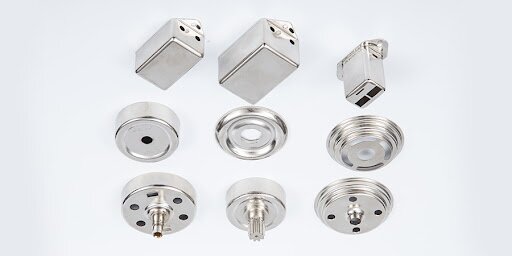
Applications of Stamped Aluminum Parts
Automotive Industry: Lightweight Components
Stamped aluminum parts are revolutionizing the automotive sector:
- Body panels: Hoods, doors, and fenders made from stamped aluminum reduce vehicle weight
- Structural components: Chassis parts and reinforcements offer strength with less mass
- Heat shields: Lightweight, heat-resistant barriers protect sensitive components
- Brackets and mounts: Durable yet light supports for various vehicle systems
- Fuel tank components: Corrosion-resistant parts for fuel storage and delivery systems
These aluminum components help automakers meet fuel efficiency standards and reduce emissions while maintaining vehicle performance and safety.
Electronics: Heat Sinks and Enclosures
The electronics industry relies heavily on stamped aluminum parts:
- Heat sinks: Efficiently dissipate heat from processors and power components
- Enclosures: Provide lightweight, durable housing for devices like laptops and smartphones
- EMI shielding: Create effective barriers against electromagnetic interference
- LED lighting fixtures: Offer excellent heat management and design flexibility
- Mounting brackets: Support circuit boards and other internal components
Stamped aluminum’s combination of thermal conductivity, lightweight, and formability makes it ideal for modern electronic devices.
Aerospace: High-Strength Aluminum Components
The aerospace industry leverages stamped aluminum for critical applications:
- Fuselage panels: Lightweight yet strong exterior components
- Wing components: Ribs, spars, and skin panels that balance strength and weight
- Interior fittings: Seat frames, overhead bin components, and galley equipment
- Fuel system parts: Corrosion-resistant components for fuel storage and distribution
- Avionics housings: Protective enclosures for sensitive electronic equipment
High-strength aluminum alloys, when stamped, provide the necessary durability and weight savings crucial for aircraft performance and fuel efficiency.
Key Challenges in Stamping Aluminum
Heat Sensitivity and Thermal Expansion in Aluminum
Aluminum’s sensitivity to heat can make stamping tricky. When heated, it expands more than steel, leading to dimensional issues in the final product. We have to control the stamping process temperature carefully to maintain precision.
Preventing Aluminum Surface Defects: Scratching and Blemishes
Aluminum’s soft nature makes it prone to scratches and blemishes during stamping. To combat this, we use specialized lubricants and coatings on our dies. We also carefully designed our tooling with polished surfaces to minimize friction.
Controlling Wear on Tooling Due to Aluminum’s Abrasiveness
Despite being soft, aluminum can be surprisingly abrasive when used as a tool. This leads to faster wear and tear on our dies and punches. To address this, we use high-strength tool steels and apply hard chrome plating to our tooling.
Conclusion
Aluminum stamping offers a perfect blend of lightweight strength and versatility. Its ability to produce complex shapes efficiently makes it invaluable across industries. As technology advances, we’ll likely see even more innovative applications of aluminum stamping, further cementing its role in creating the products of tomorrow.
Do you need a reliable sheet metal parts manufacturer? Shengen is the place to go. We specialize in sheet metal laser cutting, stamping, surface finish, and sheet metal welding. Reach out to Shengen Today and seek help from professionals!
FAQs
What is the most commonly used aluminum grade for stamping?
The 3003 alloy is often the go-to choice for stamping. It offers a good balance of formability and strength, making it suitable for various applications. Its corrosion resistance and weldability add to its popularity in the stamping industry.
Is Aluminum Good for Stamping?
Yes, aluminum is excellent for stamping. Its high formability allows for complex shapes, while its lightweight nature reduces material and transportation costs. Aluminum’s natural corrosion resistance and ability to be recycled make it an environmentally friendly choice for stamped parts.
How does aluminum compare to steel in stamping processes?
Aluminum is lighter and more formable than steel, allowing for more intricate designs with less force. However, it’s softer, which can lead to tool wear. Steel is stronger and often cheaper but heavier. Aluminum’s thermal conductivity is higher, which can affect stamping speeds.
Can aluminum be deep-drawn without cracking?
Yes, aluminum can be deep-drawn without cracking when proper techniques are used. Success depends on selecting the right alloy, using appropriate lubrication, and designing tools with suitable draw ratios. Annealing the aluminum before deep drawing can increase its formability.
More Resources:
Stamping (metalworking) – Source: Wikipedia
Hey, I'm Kevin Lee

For the past 10 years, I’ve been immersed in various forms of sheet metal fabrication, sharing cool insights here from my experiences across diverse workshops.
Get in touch

Kevin Lee
I have over ten years of professional experience in sheet metal fabrication, specializing in laser cutting, bending, welding, and surface treatment techniques. As the Technical Director at Shengen, I am committed to solving complex manufacturing challenges and driving innovation and quality in each project.


